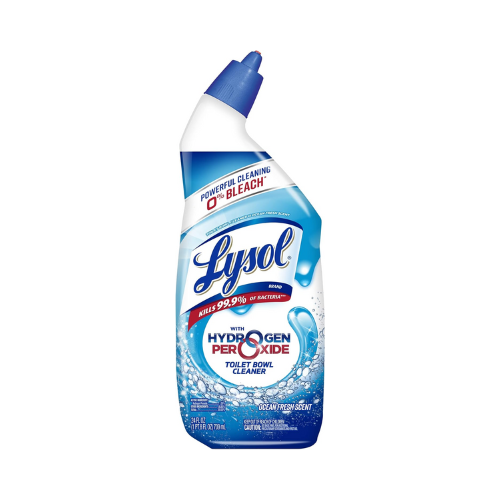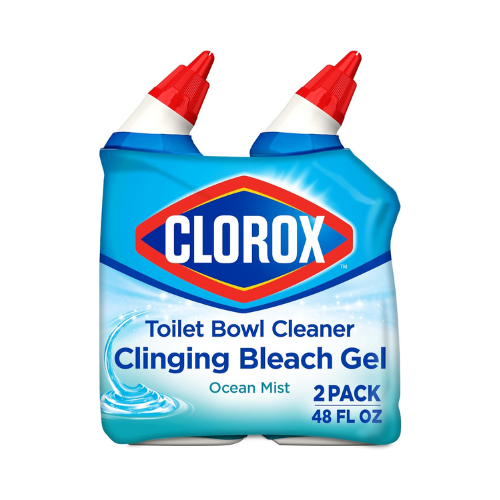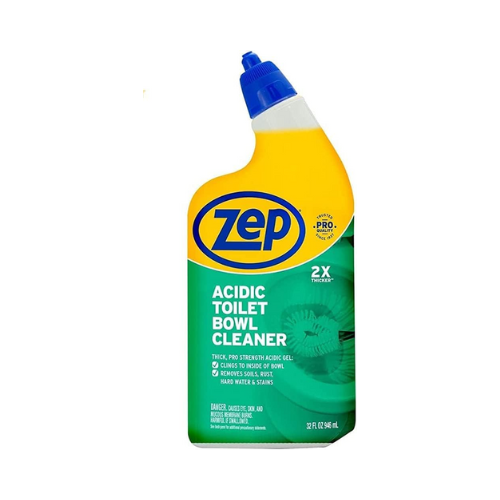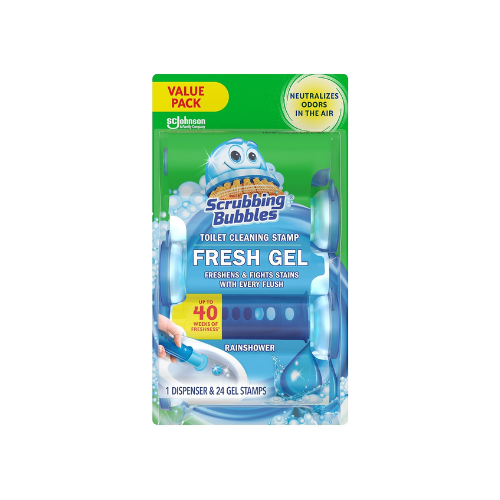The Best Toilet Bowl Cleaners, According to Cleaning Experts

Our editors independently select the products we recommend. We may earn a commission on items bought through our links.
The cleanliness of a toilet, be it at home or in a public setting, is a hamster wheel by nature. It gets cleaned to get dirty again, and on and on. It’s a necessary unpleasantry of human existence, but it can be made exponentially more pleasant with a diligent cleaning routine. Cleaning one of life’s dirtiest surfaces means finding the right industrial-grade toilet bowl cleaner and using it diligently.
Today's Top Deals
The best toilet bowl cleaners break down whatever refuses to leave the bowl, whether that’s organic waste or build-up and stains from hard water. Given a few minutes to work, the strong chemicals in these specialized cleaners turn unending scrubbing into mere minutes of work complete with a satisfying flush to finish the job and wash the filth away.
What the Experts Say
SPY spoke with three experts to understand what goes into toilet bowl cleaners and how they work, including Angela Brown, the founder of Savvy Cleaner, a training program for house cleaners and maids; Aaron Christensen, cleaning expert and VP of growth at Homeaglow; and Ryan Knoll, the owner of the cleaning service Tidy Casa.
The first thing to understand to make a good purchase is the two kinds of toilet bowl cleaners: acidic cleaners and alkaline (aka basic) cleaners. Acidic cleaners, as their name suggests, rely on low-pH acids to clean toilets. Common acids used include hydrogen peroxide, citric acid, hydrochloric acid, and vinegar for DIY solutions. Alkaline cleaners rely on high-pH chemicals, with the most common being bleach, which is typically sodium hypochlorite aka chlorine bleach. Though both kinds of toilet bowl cleaners are better than nothing, they’re better suited to different kinds of cleaning, Brown says. “[Acidic] cleaners have a low pH, often below 3. They are designed to remove hard water stains, mineral deposits, and rust from the toilet bowl,” she says. “[Alkaline] cleaners have a high pH, often above 11. They are formulated to dissolve organic matter, like urine and feces, and can also kill bacteria and viruses.”
Another key consideration is septic tanks. In particular, bleach is known to mess with septic tanks, so those who have them should avoid bleach-based toilet bowl cleaners. “If you have a septic system, double-check that your toilet bowl cleaner is labeled septic-safe,” Christensen says. “In general, avoid getting bleach- or ammonia-based cleaners into your water if you have a septic.” Realistically, the amount of bleach required to wreck the septic tank will be far more than any person will reasonably end up using through a cleaner, but it’s still an important consideration.
Speaking of tanks, all three experts note that putting any kind of cleaner, pod or otherwise, into the toilet’s tank is a bad idea because the chemicals can damage the toilet’s functional parts. “Most plumbers do not suggest using these tablets because they can lead to corrosion on the mechanical parts of the toilet, which will need replacing over time,” Knoll says. However, pods that stick to the side of the bowl are toilet-safe, though they’re much better at maintaining a clean toilet than doing the cleaning.
Most toilet bowl cleaners have a similar formula with the same chemicals. That means look for spout dispensers that make getting under the bowl’s rim easier, go for a personally appealing fragrance, and don’t spend more than $5, give or take a few dollars. Prices this low often vary by that much or more depending on where the toilet bowl cleaner is bought. Multipacks can also bring the price way down per bottle. And whichever kind of toilet bowl cleaner suits best, let it sit for at least 10 minutes for the chemicals to work before scouring the bowl with a toilet bowl brush. Christensen recommends tidying up the rest of the bathroom while waiting for the cleaner to sink in. For best results, a second application will get anything missed by the first.

BEST OVERALL
Lysol Toilet Bowl Cleaner
Buy Now On Amazon
For a strong-cleaning, septic-safe toilet bowl cleaner, the Lysol Toilet Bowl Cleaner Gel with Hydrogen Peroxide is a safe bet. It’s sticky to the inside of the bowl, contains no bleach, and works well for common hard water stains and minerals. “My personal favorites are gel-based and bleach-free like Lysol’s Toilet Bowl Cleaner Gel with Hydrogen Peroxide,” Christensen says. At a little over $3 a bottle, it’s perfectly affordable too, and a relatively gentle toilet bowl cleaner suitable for any toilet or home situation.

BEST WITH BLEACH
Clorox Toilet Bowl Cleaner
Buy Now On Amazon
On the other side of the pH scale, the Clorox Toilet Bowl Cleaner Clinging Bleach Gel relies on high-pH bleach to break down organic matter and sanitize toilets. “Clorox Toilet Bowl Cleaner with Bleach is always a good choice as it is effective in getting rid of bacteria and other germs and helps whiten the bowl,” Knoll says.
With a sticky gel formulation, this toilet bowl cleaner clings to the inside of the bowl, giving the bleach time to work. At just over $5 for two bottles, it’s a great value, highly effective, and one of the best-reviewed toilet bowl cleaners on Amazon, too.

ACIDIC CLEANER
Zep Acidic Toilet Bowl Cleaner
Buy Now On Amazon
Buy at walmart
The Zep Acidic Toilet Bowl Cleaner sees as much professional use as it does personal use due to its use of highly acidic hydrochloric acid. That makes it great for standard hard water stains but also the more difficult to eradicate rust. “The unique clinging formula allows extended contact time to remove rust, scale, stains, and residue,” Brown says, adding that it’s septic-safe and easy to use with the built-in squirt top.
Sure, the Zep Acidic Toilet Bowl Cleaner might feel “pricey” at $5 per bottle when cheaper options exist, but deep cleans require strong acids, and that’s what makes Zep one of the most popular cleaners among cleaning professionals.

NO-HASSLE CLEANER
Scrubbing Bubbles Toilet Gel Stamps
Buy Now On Amazon
Scrubbing Bubbles changed the toilet bowl game for good when it came up with the Scrubbing Bubbles Toilet Gel Stamps. These so-called gel stamps stick like a pod to the inside of the bowl, releasing a little bit of cleaning chemicals with every flush. Though they and their similar in-bowl toilet cleaners won’t be as effective at cleaning a bowl as using a liquid cleaner and brush, they seriously simplify maintenance and add much-needed freshness to the toilet and bathroom.
With their convenience, they are more expensive than bottled toilet bowl cleaners, but if $13 is the price for dozens of weeks of extra freshness or additional weeks between serious cleanings, then these are a steal.
Frequently Asked Questions About Toilet Bowl Cleaner
What’s the Best Toilet Bowl Cleaner?
“Different cleaners may be more effective for various cleaning tasks, such as removing hard water stains, disinfecting, or just for maintenance and freshness,” Brown says. “The choice of cleaner can depend on the specific cleaning needs, environmental concerns, and chemical sensitivity.”
More specifically, acidic cleaners (low pH) tend to work best for hard water stains, mineral buildup, and rust, while alkaline cleaners (high pH), typically with bleach, are best for stains from organic waste.
Regardless of the kind of stain, liquid and gel cleaners tend to be the most effective for their thorough coverage and exposure times.
Are Toilet-Cleaning Pods Safe For the Toilet?
That depends: Experts say pods or cleaners that go in the bowl itself are OK but they do not recommend any pods that go into the toilet’s tank. “If someone wants to use toilet cleaning pods, I would recommend ones that go in the bowl rather than the tank [because] there are plastic and rubber parts in a toilet tank that could be damaged by harsh chemicals,” Christensen says. Knoll and Brown both agree, saying those internal parts weren’t meant to encounter such chemicals.
How Do I Use a Toilet Bowl Cleaner?
Knoll has a pretty quick rundown of how to go about the cleaning process for best results: “For under rim toilet bowl cleaners, squirt the cleaner under the rim and let sit for about 10 minutes. Then use a brush to clean under the rim and the bowl of the toilet,” he says. “The key is to let the cleaner sit for a few minutes so the chemicals can do their job. Don’t just spray and flush because then you are just rinsing the cleaner down the drain.” Every expert agrees that exposure time is important, so make it at least 10 minutes or more.
Brown also recommends opening the toilet bowl cleaner over the open toilet to avoid any leaks or spurts. “Due to the strong chemicals in toilet bowl cleaners, anything it drips on (carpets, rugs, cleaning cloths, cleaning caddies, etc.) will be stained,” she says.
In terms of toilet bowl brushes, Christensen suggests buying one like this with an extra-long handle that matches the shape of the toilet bowl opening to allow some reasonable distance.
Can I Use Toilet Bowl Cleaner to Clean Other Things?
That’s a hard no, Brown says. “Because toilet bowl cleaners are REALLY STRONG, don’t use them on anything but a porcelain-coated or ceramic-coated toilet bowl,” she advises. “Toilet bowl cleaners should not be used in fiberglass or acrylic showers, tubs, grout, and other icky areas.”
Compared to household cleaners meant for other surfaces, toilet bowl cleaners use kinds and amounts of chemicals not meant for safe human contact. Leave the toilet bowl cleaner for the toilet.
Proceed to Check Out
The Informant: The Bidet is the Best Way to Get Your Backside Clean
The Best Bath Mats for Cleanliness and Protection, According to Home Design Experts
The Best Shower Caddies, According to Professional Home Organizers
More Top Deals from SPY
Best of SPY
